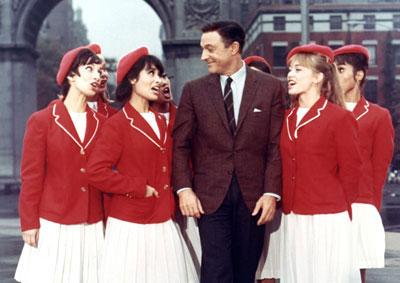Omnibus: "Dancing: A Man's Game" (NBC, 12/21/58)
Robert Saudek Associates in association with the NBC Television Network. Producers: Robert Saudek, George M. Benson, Walter Kerr, Mary V. Ahern, Alistair Cooke, Richard H. Thomas. Directors: Gene Kelly, William A. Graham. Writer: Gene Kelly. Host: Alistair Cooke. Cast: Gene Kelly, Dick Button, Bob Cousy, Vic Ghezzi, Mickey Mantle, Sugar Ray Robinson, Vic Seixas, Johnny Unitas, David Sime, Bill Corbalis, Charles Keosseian, Fred Orlovsky, Andy Pasinski, Milan Trnka. Solo dancers, Patrick Aidarte, Edward Villella, Lou Wills, Jr.
Digital Betacam, b/w, 60 min.
Until the late 1950’s Gene Kelly, though no stranger to television, had resisted any serious involvement with the medium. His dramatic TV debut was as a one-armed tramp who falls in love with an angelic deaf-mute in the Schlitz Playhouse adaptation of Flannery O’Connor’s story “The Love You Save” (CBS, 3/1/57). Two days later, he was interviewed by Dave Garroway on an installment of NBC’s Wide Wide World entitled “A Man’s Story.” Other brief small screen appearances of the period included a mystery guest stint on What’s My Line (CBS, 6/23/57) and a conversation with Edward R. Murrow on the popular interview program Person To Person (CBS, 12/19/58). But as the decade progressed, and as he became increasingly concerned over cutbacks in Hollywood musical feature production, Kelly, along with Fred Astaire, saw that television represented a new arena in which music and dance could be presented in novel and exciting ways.
At the urging of Alistair Cook, host of the prestigious Omnibus series, Kelly was invited to create for the program, a look at the relationship between dance and athletics. Growing up in Pittsburgh, Kelly had harbored aspirations of becoming an athlete (in high school he was an avid participant in football, hockey and gymnastics) and throughout his life he worked tirelessly to overcome the perceived association between dance and effeminacy. “My two loves are dancing and sports,” Kelly wrote. “I know that the foundation of my dance style is a 50-50 mixture of ballet and athletic training, and where one leaves off and the other begins, I am never quite sure.” Consequently, when given the opportunity to write, choreograph and direct “Dancing: A Man’s Game,” Kelly pointedly established a firm link between dance and sports. The lengthy soundstage tracking shot early in the show is a case in point. Along with a group of male dancers warming up, sports superstars including Mickey Mantle, Bob Cousy, Johnny Unitas and Sugar Ray Robinson are shown in motion, after which Kelly modifies their actions into dance movements. Other highlights include Kelly in a delightful tap-dance duet with boxer Robinson; a demonstration of how modern tap developed out of a combination of Irish clog dancing and African American minstrel turns to create a thoroughly distinctive style of American dance; young dancer Patrick Adiarte and Kelly on the modernization of tap through a synthesis of old forms with new rhythms; a look at the similarities between skating and ballet intercut between world champion figure-skater Dick Button and dancer Edward Villella; and an dramatic finale reminiscent of West Side Story, choreographed and performed by Kelly to music by George Gershwin. The entire hour, as described by Variety, was a “stunning production, expertly directed and executed…which fused and counterpointed the physical movement and rhythm of athletes with today’s dance…as high on entertainment value as it was informative.” Hailed a masterpiece by viewers and television critics nationwide, the program certainly contributed to Omnibus being awarded an Emmy statuette as “Best Public Service Program or Series” for 1958. Kelly himself received an Emmy nomination for “Best Choreography for Television” and the broadcast’s success encouraged him to continue his video explorations of dance on television; his next projects being two color Pontiac Star Parade specials produced in 1959, both preserved by UCLA Film & Television Archive and screened in 1995 as part of the Archive’s Seventh Annual Festival of Preservation.
—Dan Einstein
Digital copy transferred from 16mm kinescope. Special thanks to: Global Imageworks—Jessica Berman-Bogdan.






 Mobile Navigation
Mobile Navigation

